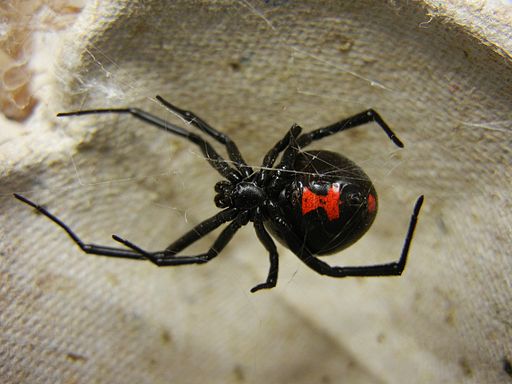![By Shenrich91 (Own work) [CC-BY-SA-3.0 (http://creativecommons.org/licenses/by-sa/3.0)], via Wikimedia Commons](https://citygirlinouterspaces.com/wp-content/uploads/2013/11/512px-Adult_Female_Black_Widow-300x225.jpg)
It was a chilly, rainy, fall morning on a farm out on the Eastern Shore. Armed with yellow rubber kitchen gloves, I began yanking up turnips from their neat little rows. Only ten minutes into the work, I found the nest. This turnip was different than the others. The ground released it easily. My first clue. Clue two: It was hollow. Clue three: There was a bundle of white threads in the ground where the turnip had been. So where was the spider?
I then looked at the other end of the turnip in my hand and there she was. Perfectly identifiable. A sleepy black widow. The good thing about these venomous spiders is that they aren’t particularly aggressive. They don’t try to run, and they won’t bite unless they feel attacked. As National Geographic puts it, they “bite only in self-defense, such as when someone accidentally sits on them.” So try not to sit on one.
I stooped there for a minute trying to figure out what to do. On the one hand, I’m not particularly fond of any spider and here I was hanging out with a poisonous one. So I should probably kill it. On the other hand, spiders are just soooo good for the environment. I let someone else decide since I was too paralyzed by my fear to make a decision. (She squashed it with her boot. It was the right thing to do.)
The woman helping me pick turnips had no idea what we were looking at. She commented that I was a spider guru, implying I had an extensive knowledge of these things. The truth is the widow is the first and only spider I learned to identify by name as a child. I was surprised that she had no idea what it was. “Is it poisonous? If someone got bit by one, should they call their doctor?” Um, yes. The bite can make any human sick, and although rare, can be fatal to young children, the elderly, or anyone with weakened immune systems.
When I pointed out the spider to the farm head, she said casually that the pickers had been seeing many of them around the farm this year. I decided to see if the increased numbers were unique to that farm. Black widow populations have shown several booms across the U.S. in recent years. Kansas reported an increase in 2013 and New York City in 2012. Scientists attribute the larger populations to milder winters and warmer summers. Another thing to look forward to with a warmer planet.
Some general things to know:
1. The female spiders are medium to smallish and are black with a red hourglass on the back (see pic). The males, which don’t have the vicious bite the females do, are brown.
2. They like dark places outside like woodpiles, patio furniture, and clutter lying around the yard. I heard of a woman getting bit once by one hiding in a cemetery vase. Careful where you put your digits.
3. When it gets cold outside, they may seek shelter indoors in attics, basements, garages, etc. We had one camping in our heater once.
4. When gardening or working around the yard or in dark spaces, wear gloves and pay attention. If you keep shoes in the garage, shine a flashlight in them before putting them on your feet.
5. If you get bit by a black widow or any spider, try to save the spider in a jar. Its identity will help you get the right treatment.
Find information on what to do if you or someone you know gets bit by a black widow spider. Whether or not you fall into one of the categories I mentioned above, it’s always best to be safe and seek medical attention immediately. Let the doctor decide if you need treatment.
Okay, time to remove this cape and shower the creepy crawlies off me.
